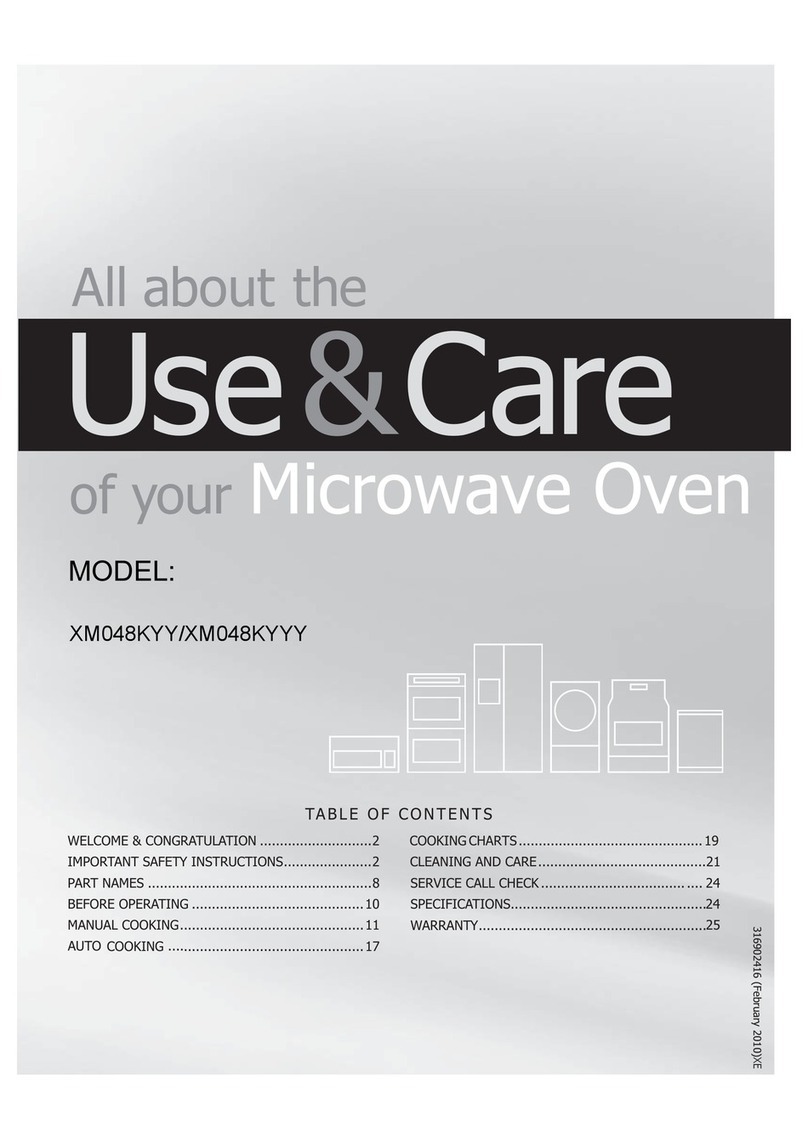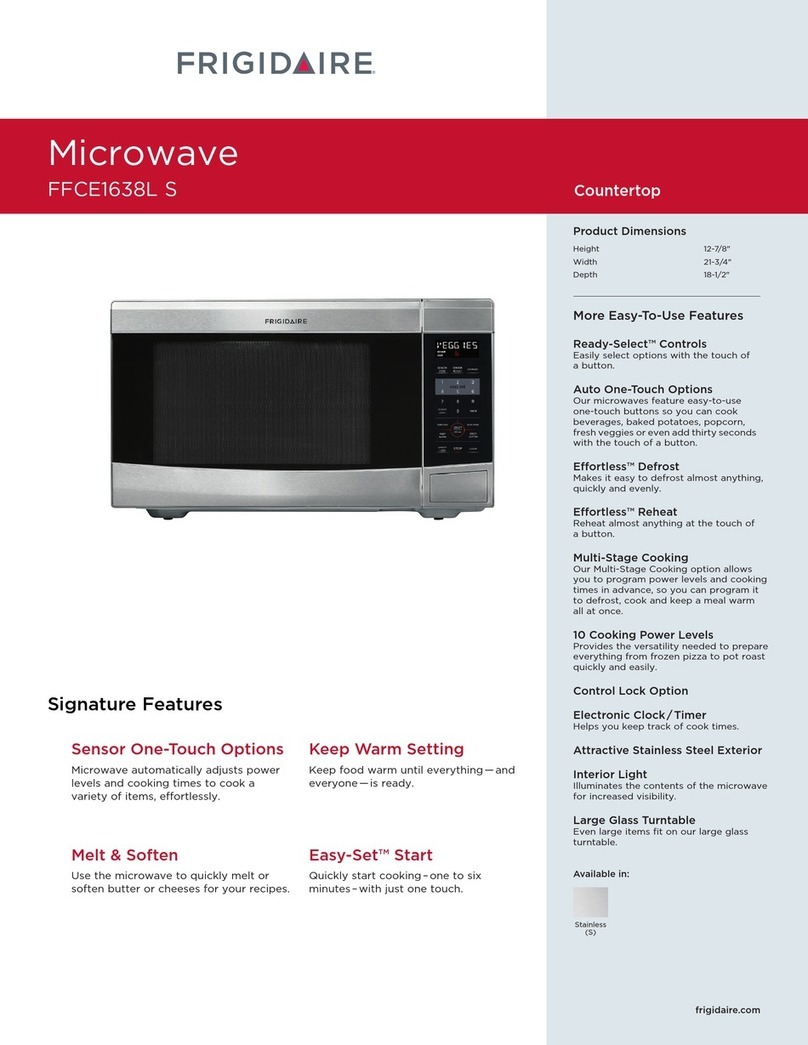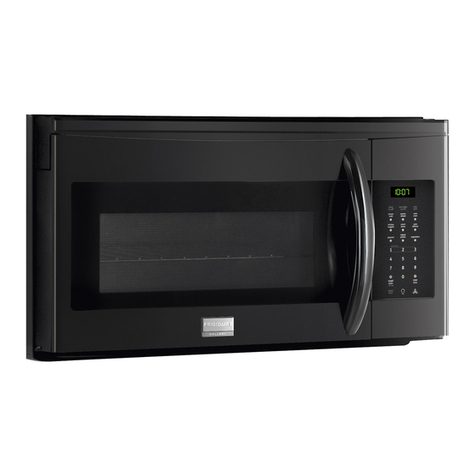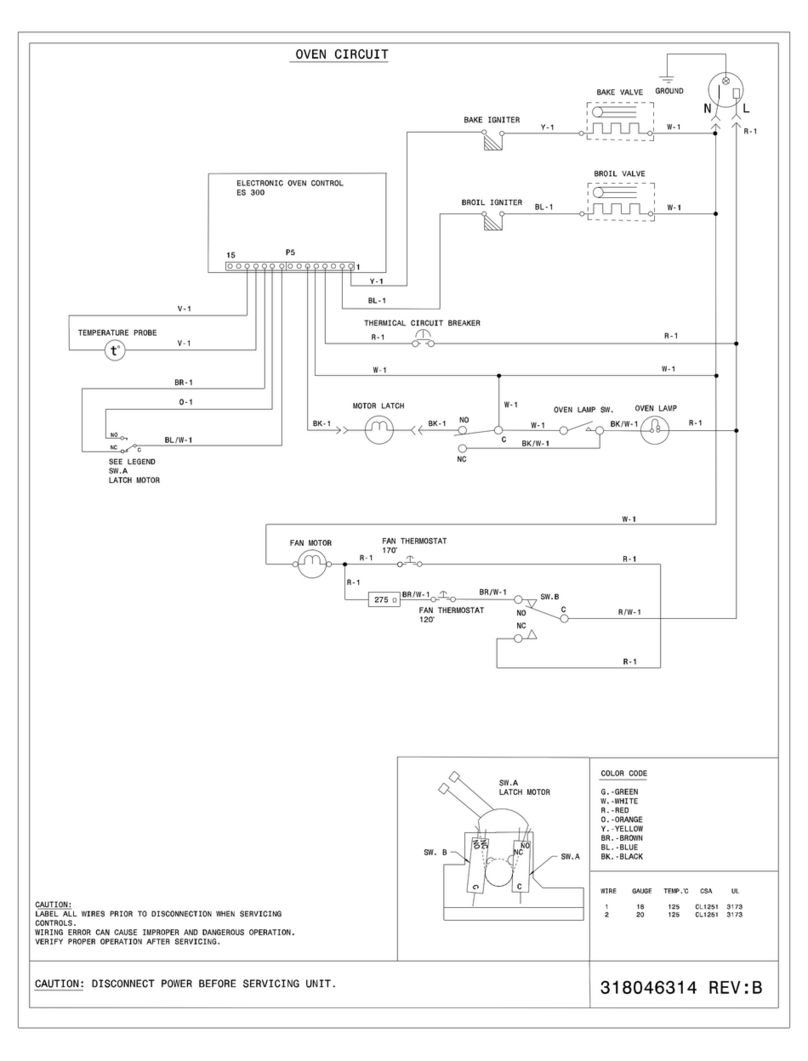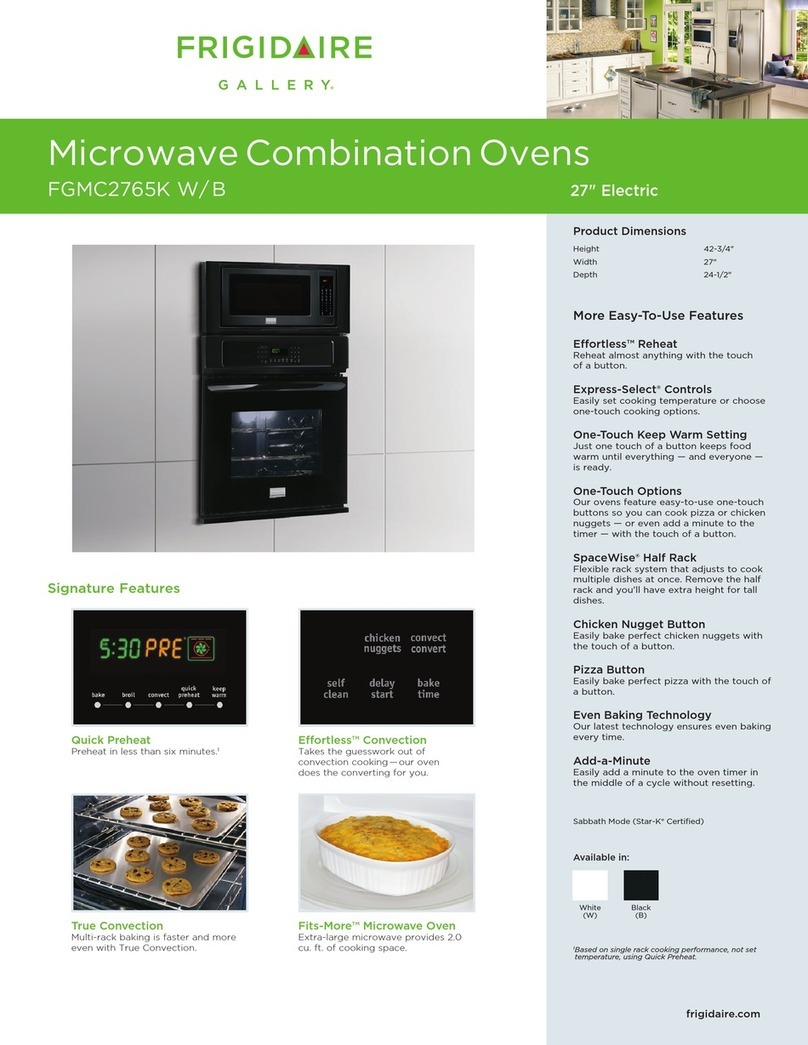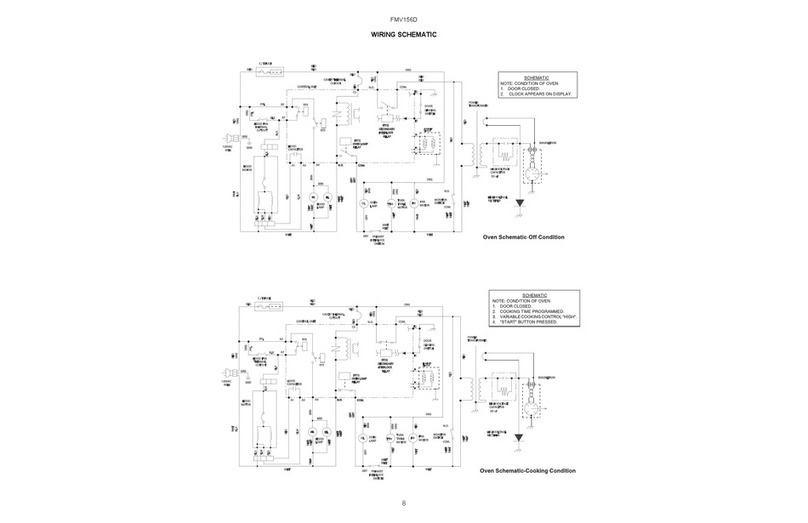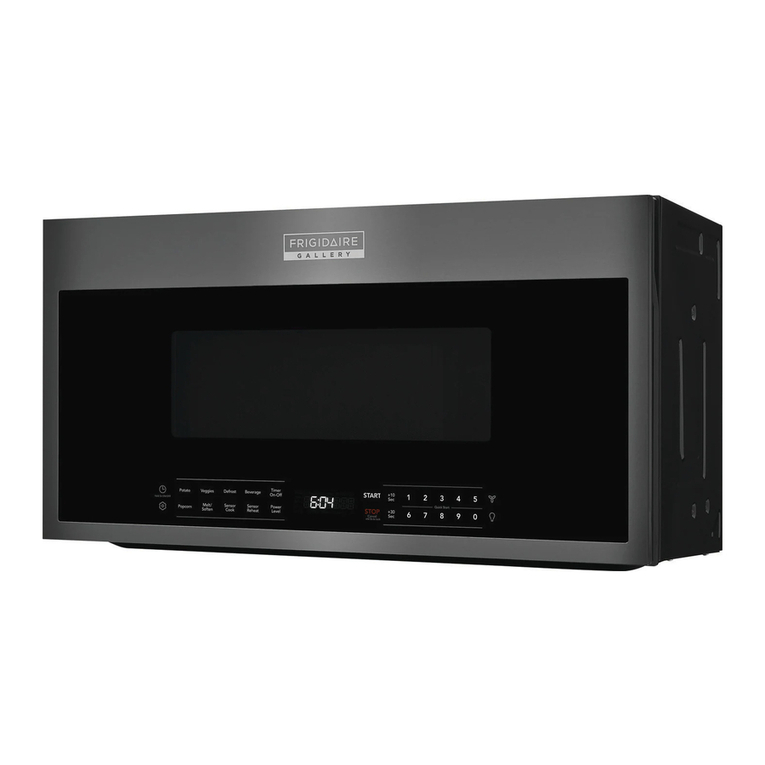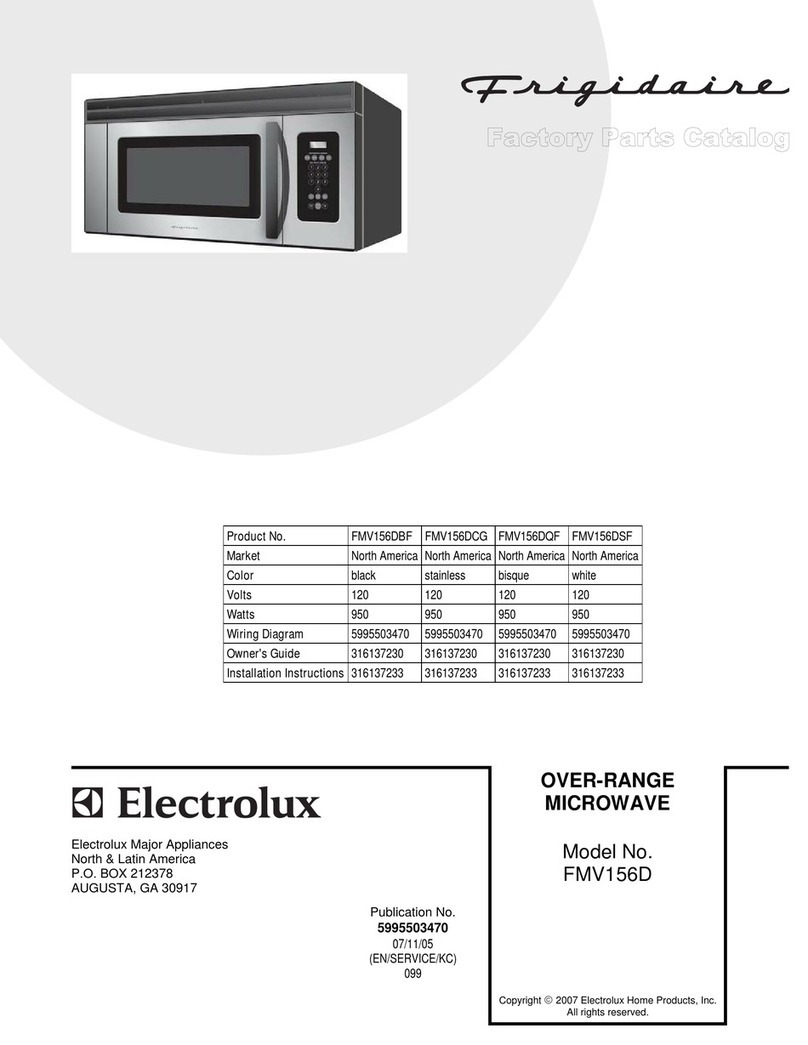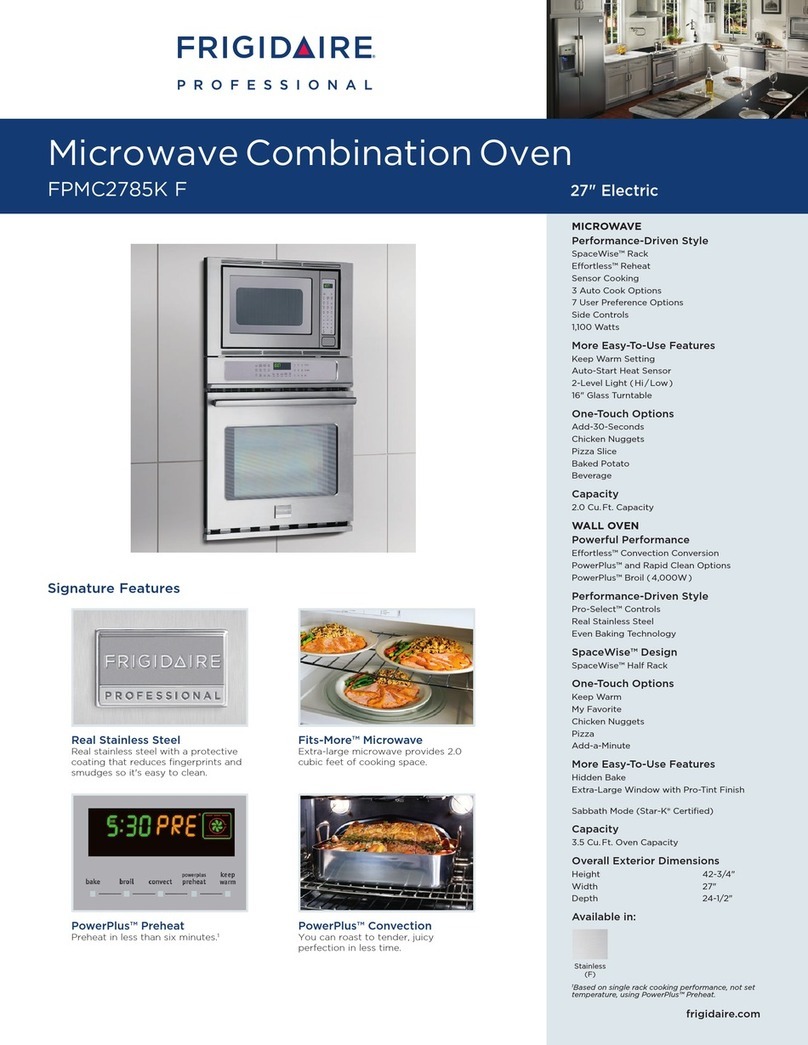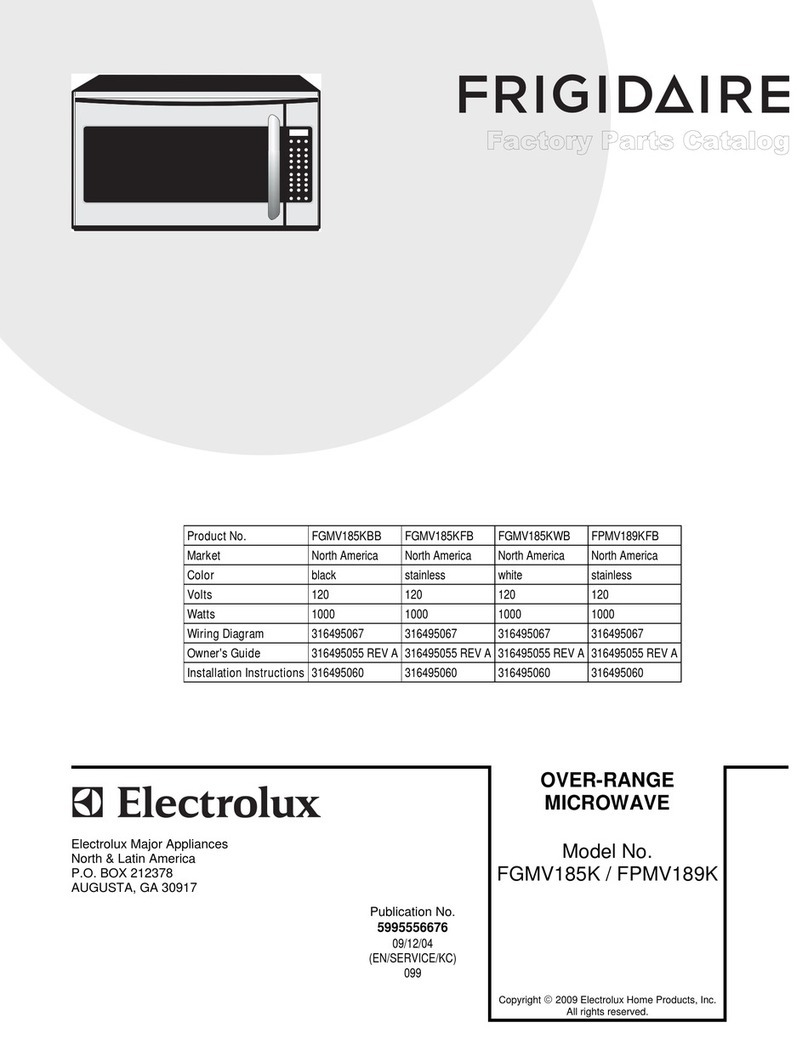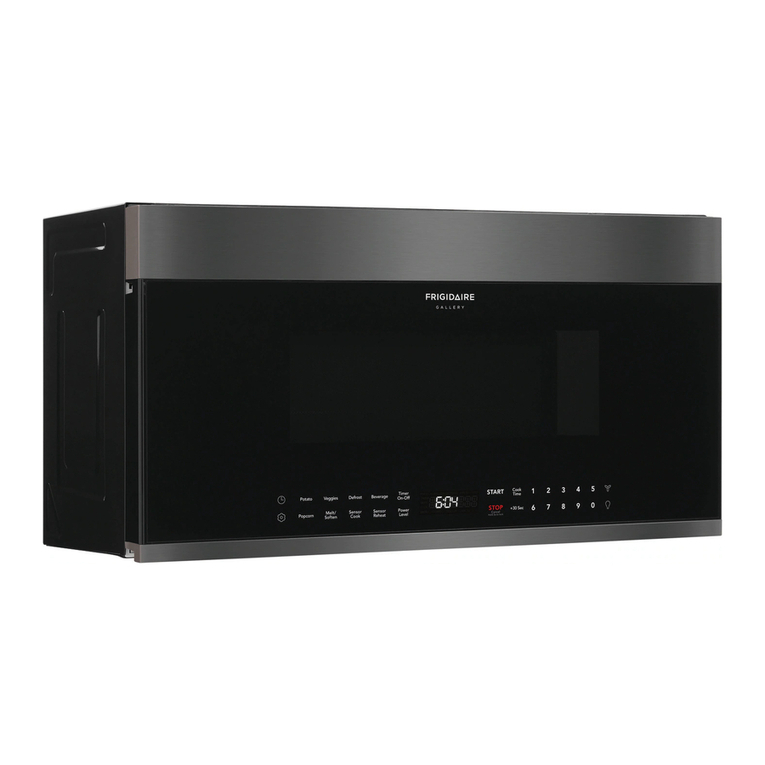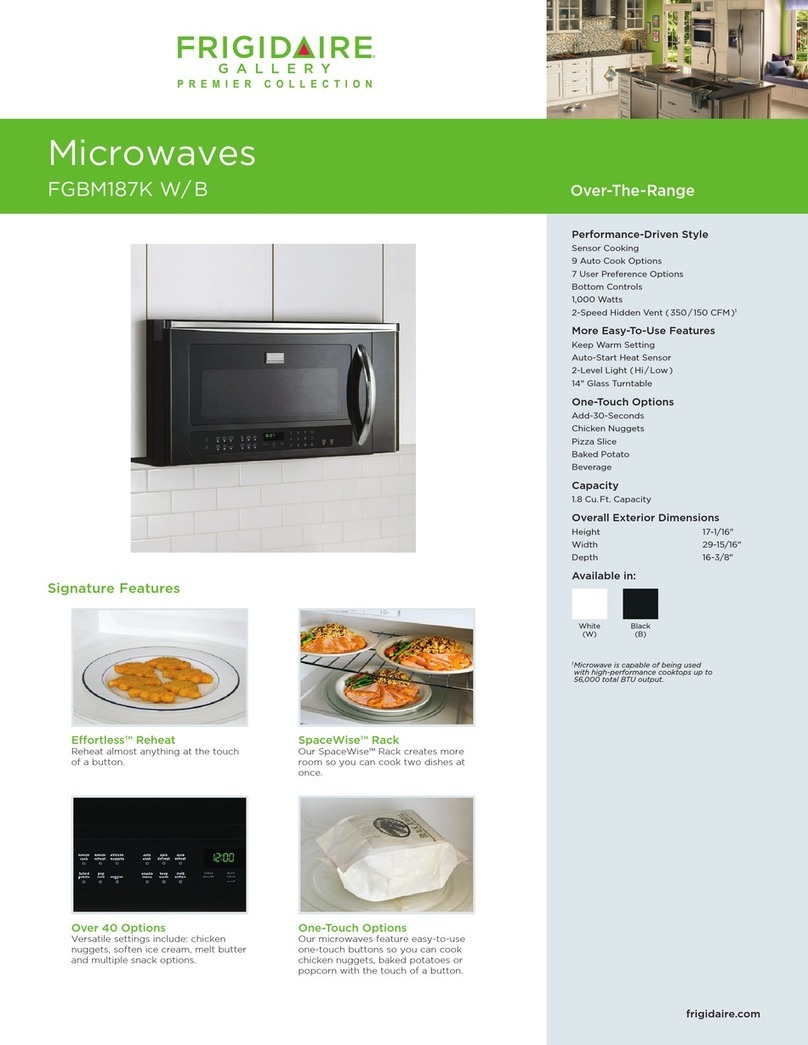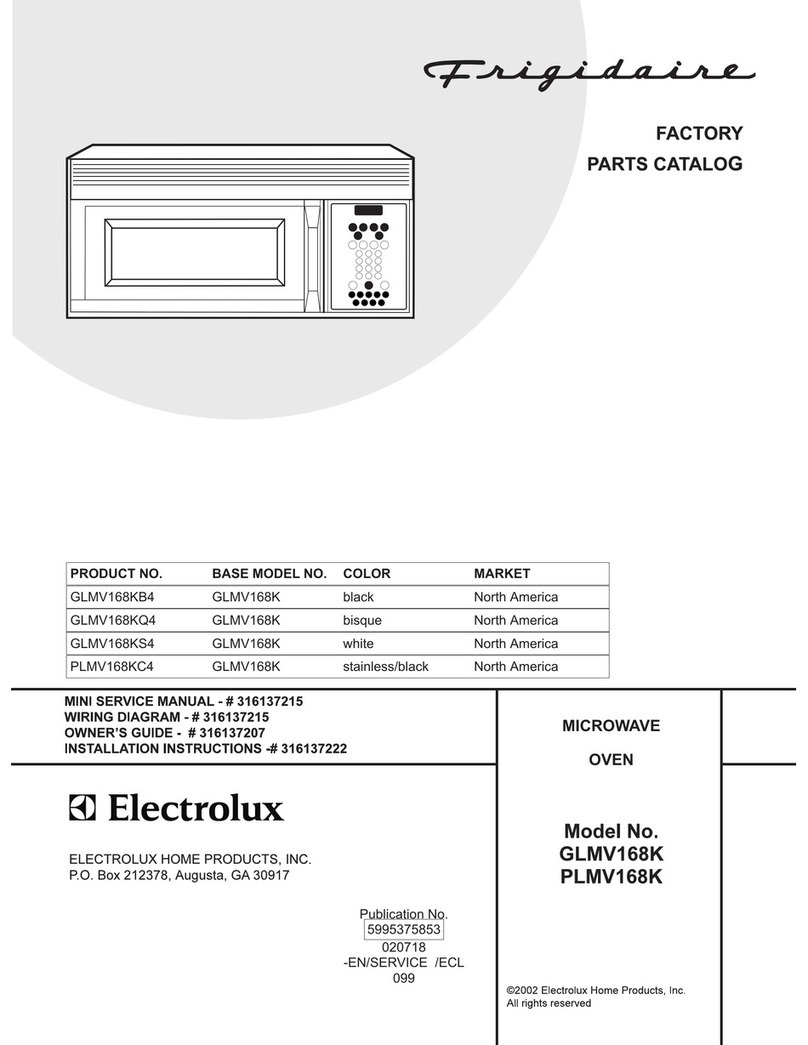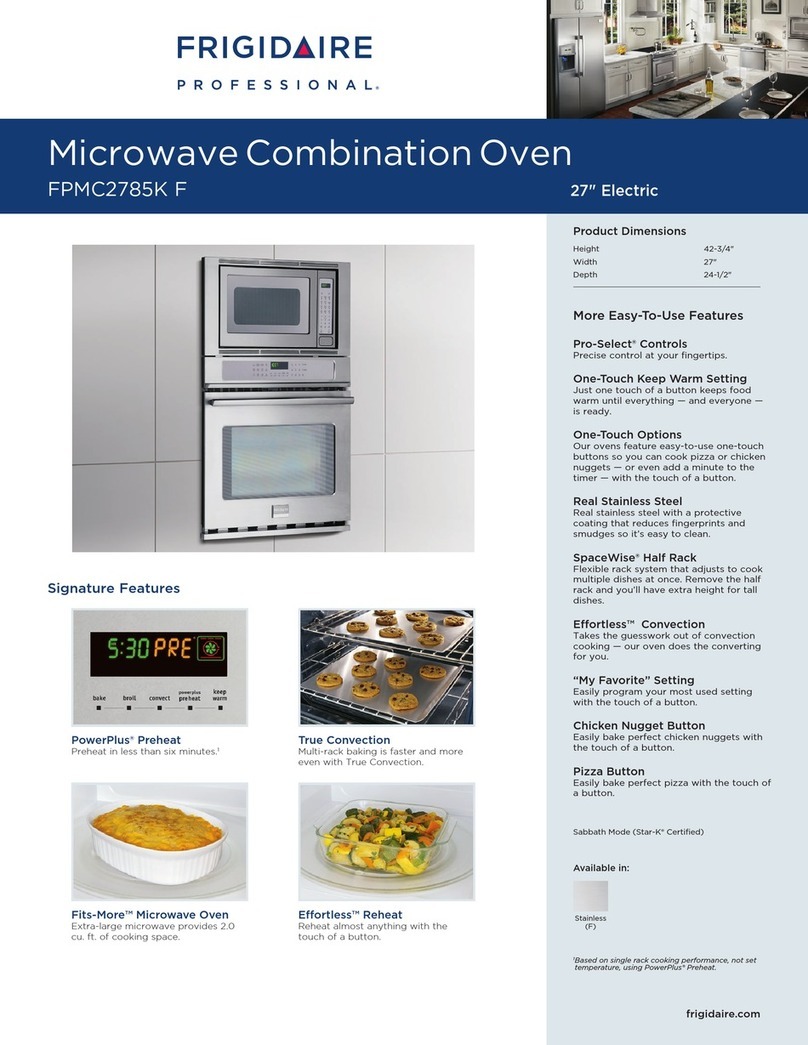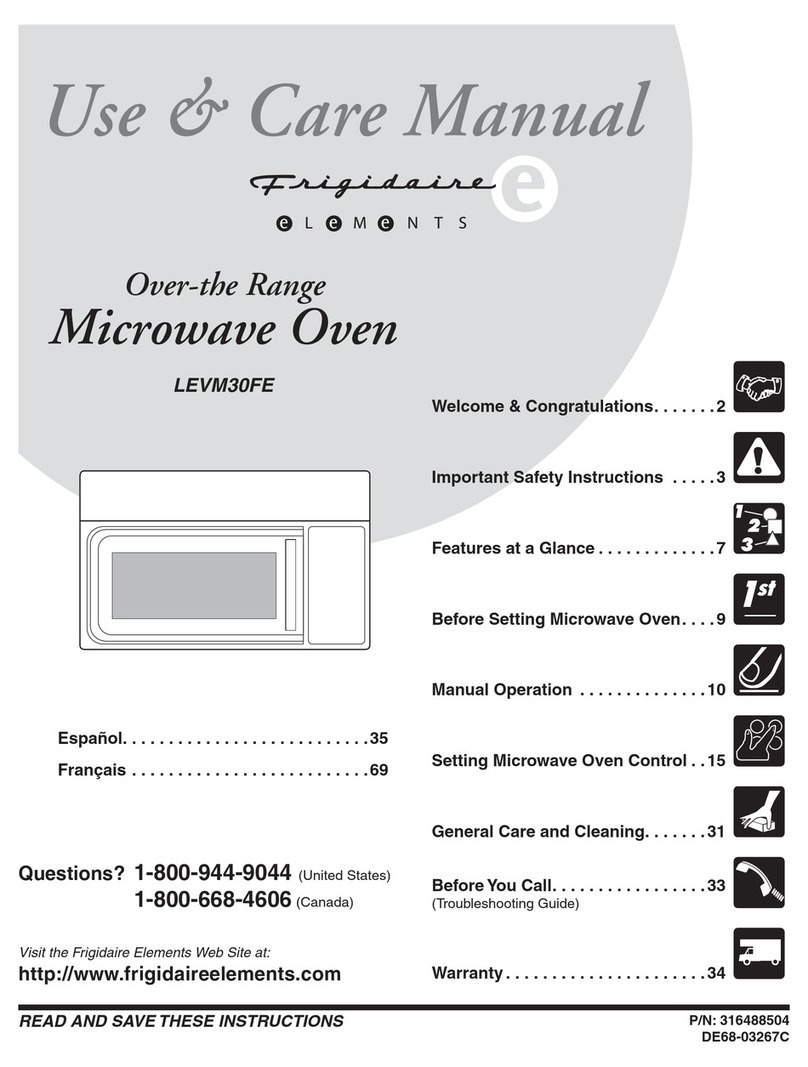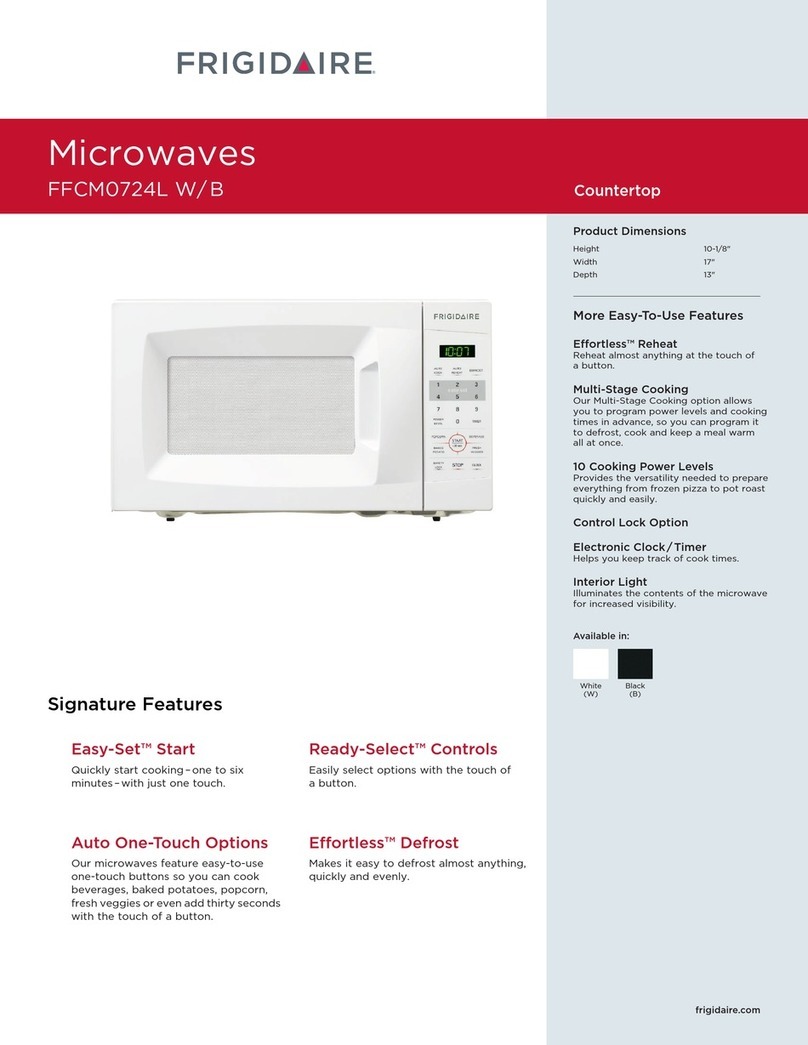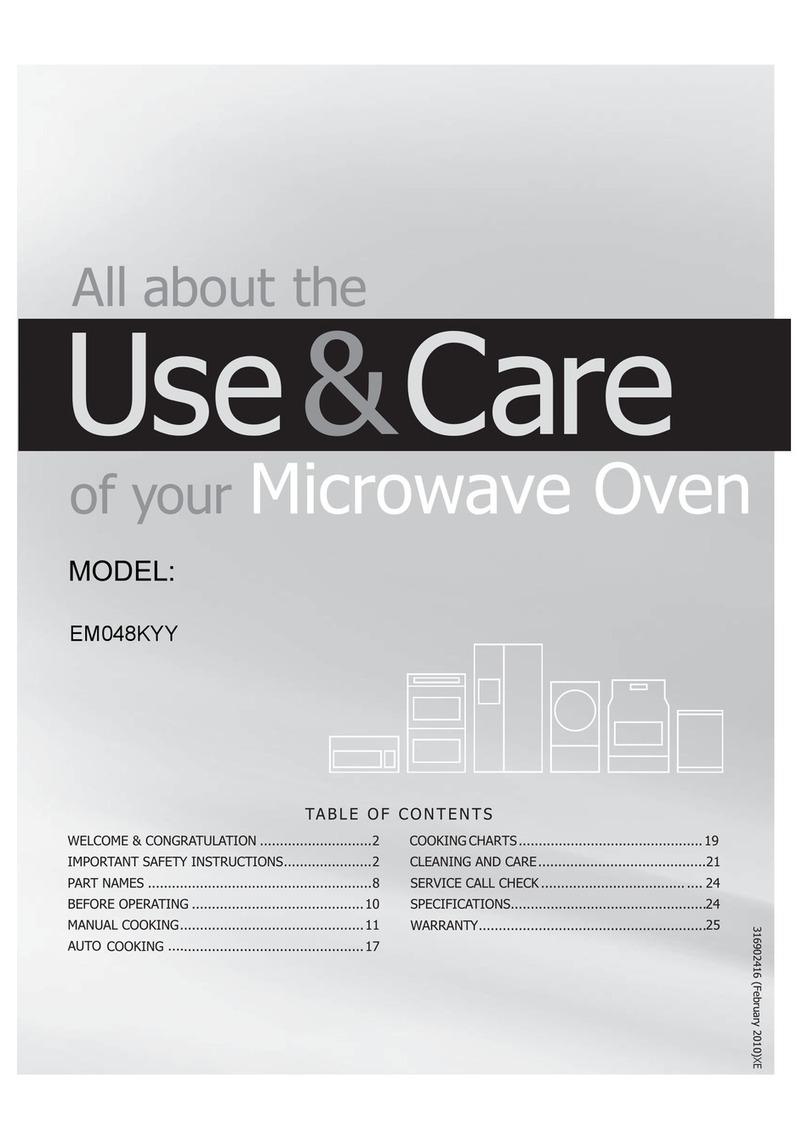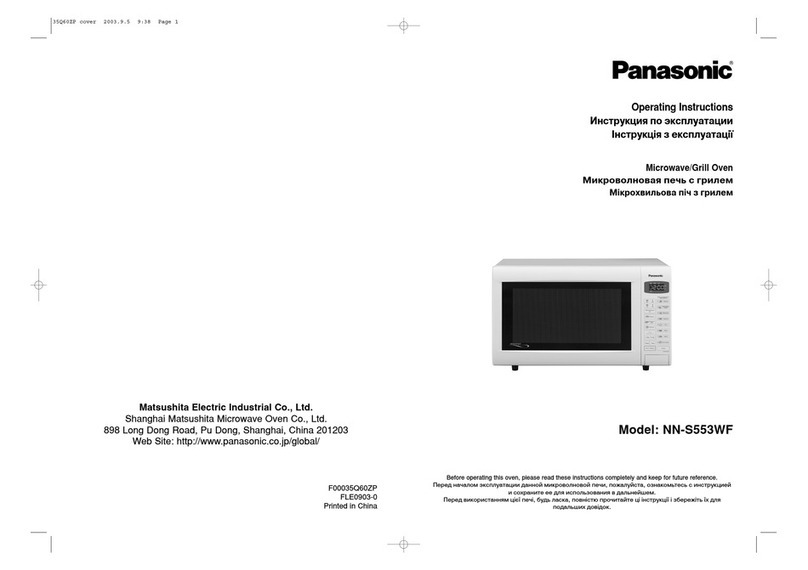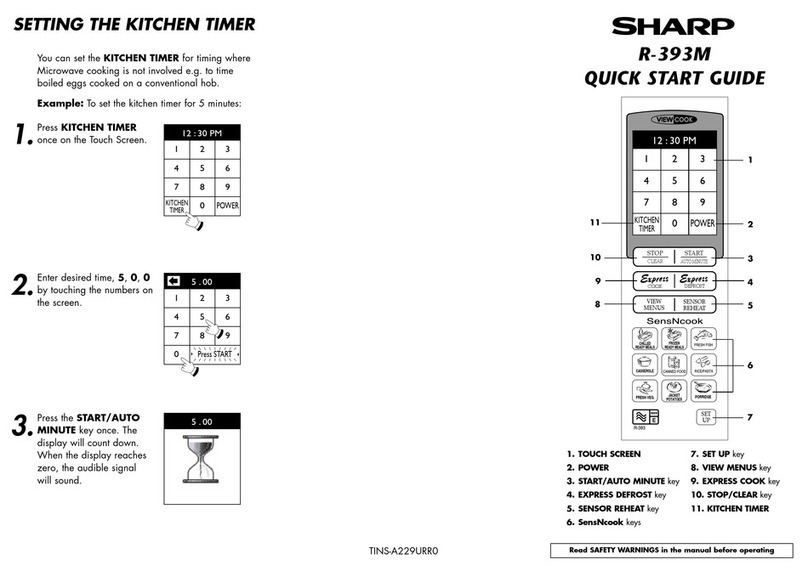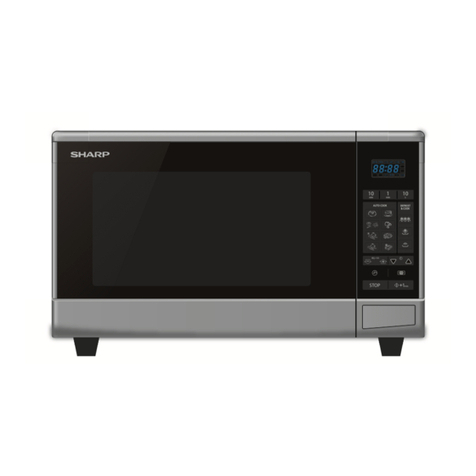PUB. NO. 31-40014
MICROWAVE OVEN HOODS
DISCONNECT POWER BEFORE SERVICING
IMPORTANT · RECONNECT
ALL GROUNDING DEVICES
ALL PARTS OF THIS APPLIANCE CAPABLE OF
CONDUCTING ELECTRICAL CURRENT ARE
GROUNDED. IF GROUNDING WIRES, SCREWS,
STRAPS, CLIPS, NUTS OR WASHERS USED TO
COMPLETE A PATH TO GROUND ARE REMOVED
FOR SERVICE, THEY MUST BE RETURNED TO
THEIR ORIGINAL POSITION AND PROPERLY
FASTENED.
GROUNDING SPECIFICATIONS
Leakage Current 0.5 mA. (Max.)
Ground Path Resistance 0.14 ohms (MAX.)
INSTALLATION REQUIREMENTS
ELECTRICAL
MWO Power 950 Watts
Power Source 120 VAC, 60 Hz.
Line Current 13.5 Amps. (1580Watts)
Over Current Protection 20 Amps *
* Requires 120 Volt, 20 Amp. parallel,
grounded separate circuit.
Working Voltage 105-130 VAC.
MICROWAVE LEAKAGE TEST
1. Place 275 ml. water in 600 ml. beaker
(WB64X5010)
2. Place beaker in center of oven shelf.
3. Set meter to 2450 MHz scale.
4. Turn oven "on" for 5 minute test.
5. Hold probe perpendicular to surface being
tested and scan surfaces at rate of one
inch/sec.
Test the following areas:
Entire perimeter of door and control panel
Viewing surface of door window
Exhaust vents
6. Maximum leakage 4 MW/CM
2
7. Record data on service invoice and
microwave leakage report.
NOTE :
Maximum allowable leakage is 5 MW/
CM
2
. 4 MW/CM
2
is used to allow for
measurement and meter accuracy.
Inform the manufacturer of any oven found to
have emission in excess of 5 MW/CM
2
. Make
repairs to bring the unit into compliance at no
cost to owner and try to determine cause.
Instruct owner not to use oven if it has not
been brought into compliance.
HIGH VOLTAGE CAPACITOR
The high voltage capacitor has an internal shunt
resistor to automatically discharge the capacitor
when the oven turns "off". Under normal
operation the capacitor should fully discharge
within 30 seconds.
PERFORMANCE TEST
1. Measure line voltage (loaded). This test is based
on normal voltage variations of 105V to 130V.
Low voltage will lower output power and
temperature rise.
2. Place WB64 X0073 beaker containing one liter
water (1000ml, 59
F~75 F) on turn table and
record the starting water temperature with
an accurate thermometor.
(DO NOT USE ANY OTHER LOAD OR DISH AS
RESULTS WILL VERY FROM STANDARD!)
3. Set at HIGH power for 2 minutes, and 3 sec.
4. Turn on the oven.
5. Record end water temperature.
The minimum difference between the initial
and ending temperature should be:
INTERLOCKS (DOOR Latch Switches)
Interlocks are designed as follows:
Primary - Bottom switch operated by bottom
latch pawl connected to line (L) leg.
HOW TO TEST INTERLOCKS
1. Disconnect power, open control panel,
and discharge capacitor.
Primary
2. Check Continuity of Com and N.O. :
Door Closed –
Door Open –
MONITOR SWITCH
The monitor switch is located between the top
and bottom interlocks. The monitor switch is
operated indirectly by the bottom latch pawl.
HOW TEST MONITOR
1. Disconnect power, open control panel, and
discharge capacitor.
2. Disconnect monitor switch leads, and test at
terminals:
Door Closed –
Door Open –
3. Reconnect switch wiring.
4. Test Circuit Operation:
A) Connect temporary jumper across relay
contacts and primary switch to simulate
shorted switch contacts. Locate
convenient connections in circuit to be
certain COM and N.O. terminals are used.
B) Connect OHM meter (Low Scale) across
the two line terminals of appliance power
cord.
Continuity must show:
Door Close –
Door Open –
C) Remove 20 Amp. Fuse
D)
WARNING!
After test remove temporary
jumper leads from interlocks and relay.
Reconnect monitor switch leads, replace
fuse.
E)
Replacement of any parts in monitor
circuit requires repeating this entire
test procedure.
IMPORTANT
:
Check for microwave leakage
after replacing or adjusting
Door, Interlock
switches or
brackets.
–Circuit must open
Ohms). If not check wiring of monitor
and interlock circuits.
FUSE
INTERLOCK REPLACEMENT
The switch housing is not adjustable. It is fixed
on the front cavity with 2 screws.
IMPORTANT - CHECK FOR MICROWAVE
LEAKAGE AFTER REPLACING OR
ADJUSTING DOOR, INTERLOCK
SWITCHES OR BRACKETS.
CAUTION !
When safety interlocks and monitor switches are
repaired or replaced, check microwave leakage.
Perform microwave leakage check, if leakage
does not exceed 4 MW/CM it is performing
properly.
2
AUTOMATIC FAN FEATURE
Exhaust fan turns "ON" automatically during
some surface unit heavy use conditions.
(Cannot be turned off manually - will turn off
automatically.) May stay on up to 15 mins.
after range and lower oven controls are
turned off.
HOOD THERMOSTAT
Single pole thermostat mounted ON R.H. side
duct in control compartment. Contacts close at
approx. 158 F.
BOTTOM THERMOSTAT
Single pole thermostat mounted on base plate.
Contacts open at approx. 248 F.
DOOR ASSEMBLY (NOT ADJUSTABLE)
The door assembly is serviceable as an
assembly or with parts.
IMPORTANT SAFETY NOTICE
THIS INFORMATION IS INTENDED FOR USE
BY INDIVIDUALS POSSESSING ADEQUATE
BACKGROUNDS OF ELECTRICAL, ELECTRONIC
AND MECHANICAL EXPERIENCE. ANY
ATTEMPT TO REPAIR A MAJOR APPLIANCE
MAY RESULT IN PERSONAL INJURY AND
PROPERTY DAMAGE. THE MANUFACTURER OR
SELLER CANNOT BE RESPONSIBLE FOR THE
INTERPRETATION OF THIS INFORMATION, NOR
CONNECTION WITH ITS USE.
CAN IT ASSUME ANY LIABILITY IN
WARNING!
WARNING!
discharged before servicing.
Always be certain the capacitor is
Discharge by placing an insulated handle
screw driver between the diode connection of
the capacitor and oven chassis ground.
TO PREVENT ELECTRICAL SHOCK, USE
EXTREME CAUTION WHEN DIAGNOSING
OVEN WITH OUTER CASE REMOVED AND
POWER "ON". THE HIGH VOLTAGE SECTION
OF THE POWER SUPPLY, INCLUDING
FILAMENT LEADS HAVE THE POTENTIAL
WITH RESPECT TO GROUND TO REACH
4000 VOLTS!
MICROWAVE LEAKAGE TEST
A microwave leakage test must be performed
any time a door is removed, replaced,
disassembled, or adjusted for any reason.
THE MAXIMUM LEAKAGE IS
4 MW/CM
2
WARNING!
When 20 Amp. fuse is blown due
to operation of the monitor switch, the monitor
switch must be replaced. Also replace relays
and / or interlock switches when continuity
check shows contacts shorted.
PRECAUTIONS TO BE
OBSERVED BEFORE AND
DURING SERVICING TO
AVOID POSSIBLE
EXPOSURE TO
EXCESSIVE MICROWAVE
ENERGY
A. IF OVEN IS OPERATIVE PERFORM
MICROWAVE EMISSION CHECK
PRIOR TO.
B. DO NOT OPERATE OR ALLOW THE
OVEN TO BE OPERATED WITH THE
DOOR OPEN.
C. IF THE OVEN OPERATES WITH THE
DOOR OPEN :
1) INSTRUCT THE USER NOT TO
OPERATE THE OVEN AND
AND THE CENTER FOR DEVICES
2) CONTACT THE MANUFACTURER
RADIOLIGICAL HEALTH
IMMEDIATELY.
CHECK THE FOLLOWING SAFETY
D.
(MWO) BEFORE ACTIVATING THE
ITEMS ON ALL MICROWAVE OVENS
MAGNETRON. MAKE REPAIRS AS
NECESSARY :
1. INTERLOCK OPERATION
2. PROPER DOOR CLOSING
3. SEAL AND SEALING SURFACES
(CHECK FOR ARCING, WEAR, AND
OTHER DAMAGE)
4. DAMAGE TO OR LOOSENING OF
HINGES AND LATCHES
5.
EVIDENCE OF DROPPING OR ABUSE
E. BEFORE TURNING ON MICROWAVE
POWER FOR ANY SERVICE TEST OR
INSPECTION WITHIN THE MICROWAVE
GENERATING COMPARTMENTS,
CHECK THE MAGNETRON, WAVE
GUIDE, AND CAVITY FOR PROPER
ALIGNMENT, INTEGRITY, AND
CONNECTIONS.
F. ANY DEFECTIVE OR MISADJUSTED
COMPONENTS IN THE INTERLOCK,
MONITOR, DOOR SEAL, AND
MICROWAVE GENERATION AND
TRANSMISSION SYSTEMS SHALL BE
REPAIRED, REPLACED, OR ADJUSTED
BY PROCEDURES DESCRIBED IN THIS
RELEASED TO THE OWNER.
MANUAL BEFORE THE OVEN IS
G.
A MICROWAVE LEAKAGE CHECK TO
VERIFY COMPLIANCE WITH THE
FEDERAL PERFORMANCE STANDARD
SHOULD BE PERFORMED ON EACH
OVEN PRIOR TO RELEASE TO THE
OWNER.
TECHNICAL DATA SHEET
MICROWAVE OVEN HOODS
WARNING
NEVER TOUCH OR SERVICE THE
HIGH VOLTAGE CIRCUIT WITHOUT
DISCHARGING CAPACITOR BY
SHORTING ACROSS ITS TERMINALS.
TO AVOID POSSIBLE ELECTRICAL
SHOCK.
OVEN THERMAL CUTOUT
(FLAME SENSOR)
The Oven Thermal Cutout is located on the top
side of the Oven Cavity beside Exhaust duct
with a temperature rating of 212 F.(100 C.) The
cutout is tightly held to the top of the oven cavity
by a spring clip.
NOTE :
If cutout cannot be removed from clip
oven will have to be removed from
installation and outer case removed.
40 F @ 120 V
ANTENNA
The antenna is motor driven and located on the
upper side of the cavity. The oven uses a top
feed wave guide. The antenna blade is located in
the wave guide and the motor is located on the
wave guide.
To Service Antenna Blade
1. Disconnect power and open the door.
2. Remove the clip and turn the antenna cover
left.
To Service Antenna Motor
1. Disconnect power and remove grille
screws(2).
2. Remove grille and the bracket duct upper
screw.
3. Remove the bracket duct upper and
disconnect the antenna motor wire.
4. Remove antenna motor screws(2) and pull the
antenna motor.
CAPACITOR AND DIODE REMOVAL
The high voltage capacitor and diode can be
serviced through Control Panel after removing
grille.
1. Disconnect power and discharge capacitor.
2.
Disconnect capacitor leads and remove 1 screw.
3. Remove bracket-capacitor.
To Service Turntable(on/off) Motor
1. Disconnect power and remove bottom plate
screws(7).
2. Remove bottom plate and disconnect the
turntable motor wire.
3. Remove turntable motor screws(2) and pull
the turntable motor.
come with it.
3. Remove antenna cover and the antenna will
MAGNETRON, MAGNETRON FAN, VENT
BLOWER AND POWER TRANSFORMER
REMOVING OVEN FROM WALL
(2 PEOPLE REQUIRED)
Oven hooked on metal tabs at bottom of wall
mounting plate and fastened to cabinet by (3)
top cabinet bolts.
CAUTION :Oven weights about 62 lbs.
Requires 2 people for removal.
1. Disconnect Power Cord, Top vented models -
disconnect duct and remove damper assembly.
2. Remove top cabinet bolts(3).
3. Pull unit forward slowly, providing adequate
support to prevent dropping unit during
removal of last top cabinet bolt.
Oven must be removed from wall.

